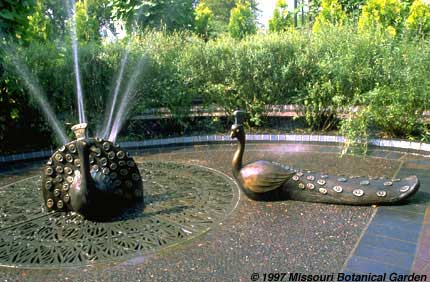

Two Playful Peacocks
Bronze
![]()
Artist:
Robert Lee Walker
American (b.1922)
Robert Lee Walker, who was born in Poplar Bluff, Missouri, grew up in St. Louis and taught sculpture at John Burroughs School in Ladue from 1950 until his retirement in 1987. From 1987 to 1993 he continued to work at Burroughs as Artist In Residence. He earned a B.F.A. from Washington University School of Fine Arts, where he studied with Carl Mose and Richard Duhme, Jr. Walker did graduate work at the Cranbrook Academy of Art from 1949 to1950, where he met and was influenced by Carl Milles and Eliel Saarinen.
![]()
Location:
Spoehrer Children's Garden in the William T.Kemper Center for Home Gardening
![]()
The bronze sculptures for the Kemper Center were commissioned by Environmental Planning and Design of Pittsburgh in 1987 at the recommendation of Alan Godlewski, the Garden's late Director of Horticulture. From the very beginning of the project, the pieces were envisioned as groupings of animals in playful interaction with water features and fountains.
In early 1993, Mr. Walker began to work on the final list of sculptures, which includes two separate groups of geese, a single fishing otter, a group of four playful otters with fish, three raccoons, a cocker spaniel warily investigating a porcupine, a prairie dog, and a pair of peacocks. In addition, Mr. Walker was asked to create bronze filigree panels for the Butterfly Pavilion and a bronze medallion for the Boxwood Garden.
"Water is an important sculptural element in these designs," Walker said. "The peacocks' tails will have moving sprays of water, and water will play from the mouths and skidding feet of the geese. I wanted to create realistic animals, but with a sense of whimsy. Some characteristics of the figures are anthropomorphic, or human-like, to accentuate this sense of play."
In his studio, Walker models the figures in oil-based clay applied over a base of carved synthetic foam. Later the sculpture is cast in bronze at a foundry in Lawrence, Kansas, using the "lost wax" method. This is an ancient technique in which workmen first make a rubber mold directly from the clay figure. The rubber mold is brushed with wax, then peeled away, leaving a hollow wax replica of the clay sculpture.
Walker frequently makes minor adjustments to the wax replica. The wax form is then dipped repeatedly into liquid ceramic "slip", which builds up into a shell about three-eighths of an inch thick. The ceramic is fired in a kiln, which melts the wax, leaving behind a hard ceramic mold. The mold is coated inside with molten bronze, and when the metal is cool, the ceramic is chipped or broken away, leaving a hollow bronze cast of Walker's original clay model. Each subsequent cast of the piece, if any, must start again with the rubber mold.
"It isn't easy to get the sculptures from my studio to the foundry," Walker said. "I usually have to cut the larger figures into pieces, and I had to build an insulated 'refrigerator' out of styrofoam to keep the clay from melting in the back of my station wagon! I don't try for profound symbolism in my work. I want it to be beautiful, with a sense of fun."
![]()